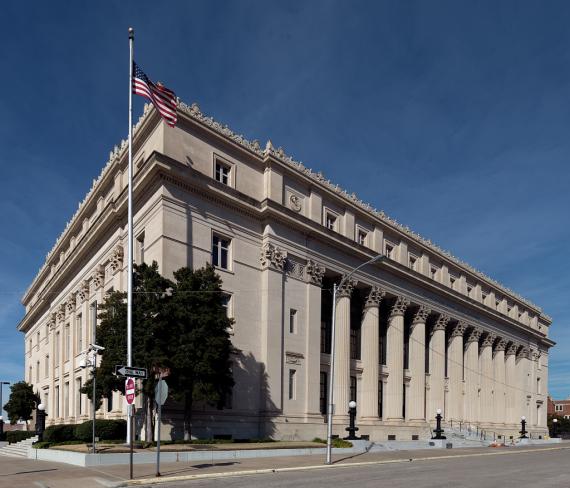Location: 101 N 5th St #210, Muskogee, OK 74401
Significance
The Muskogee Federal Building- U.S. Courthouse is significant as the city’s best example of Neo Classical Revival/Second Renaissance Revival architecture and the early embodiment of federal government in the region. It is a well designed building using high quality materials. Design and Construction supervision was provided by the U.S. Treasury with James Knox Taylor as supervising architect. Its subdued classical detailing and ornamentation convey the governmental functions inside while blending well with contemporary architecture. The building’s style also integrates well with Muskogee’s less urban setting. The subdued classical design together with the use of modern elements, such as the Chicago styled window grilles, results in a design that represents an early departure from the Second Renaissance Revival and Beaux Arts styling that was typical of the government’s previous buildings.
The federal building was constructed on a site that was occupied by five simple wood frame houses on the western edge of the center of town adjacent to several churches and hotels of quality architecture. The building was constructed (completed in 1915) shortly after the statehood in 1907 and prior to the construction of the U.S. Post Office and Federal Building in nearby Tulsa. When the building opened (public opening November 26, 1915), it was “… the most noted architectural achievement in the state.” The construction cost $500,000 and the interior furnishings another $250,000. The building was designed as a United States Post Office and Courthouse (original name) and functioned as a complete federal center for the region. This included, in addition to the post office and court operations, general offices for the Internal Revenue, the Union Indian Agency, and Royalty amongst others. Judge Ralph E. Campbell presided over the first court session.
The federal presence in Muskogee began in April, 1889 when Hon. James M. Shackelford opened a session of the U.S. District Court in an old wood frame structure on the corner of Main and Okmulgee known as the “Phoenix Building”. At that time Muskogee was a border (to the Indian Territory) town of 2,500 inhabitants. In 1894 The U.S. Congress passed a law that created The Henry L. Dawes Commission. The work of the Dawes Commission, in summary, was to distribute approximately 20 million acres of land to approximately one hundred thousand individual Indian citizens of the Five Civilized Tribes, Cherokee, Creek, Choctow, Chickasaw, and Seminole. The Commission played an important role in establishing census roles, land allotments, and federal negotiations with Native Americans in the Indian Territory and was the required precursor for Oklahoma statehood. The presence of the Commission was a major influence on the early growth of Muskogee and nearby communities. The Muskogee Federal Building was designed to accommodate the Dawes Commission offices which emerged with the Commission to the Fove Civilized Tribes which then merged with the United States Indian agency prior to the original opening of the building. This territorial history is an added dimension to the historical significance of the building.
In 1937 the U.S. Treasury with Loius A. Simon as supervising architect designed the primary addition to the west side of the building. The addition provided covered loading and parking for the post office, added a courtroom on the second floor, and expanded the office space on each floor including the firth which was previously a storage area. Currently the building is utilized as a federal building and courthouse. The post office moved to an adjacent new one story building in 1965. There are now three courtrooms (the third was added by GSA in 1982), court and district attorney offices, FBI, U.S. Marshals, BIA, and related offices.

 U.S. General Services Administration
U.S. General Services Administration
